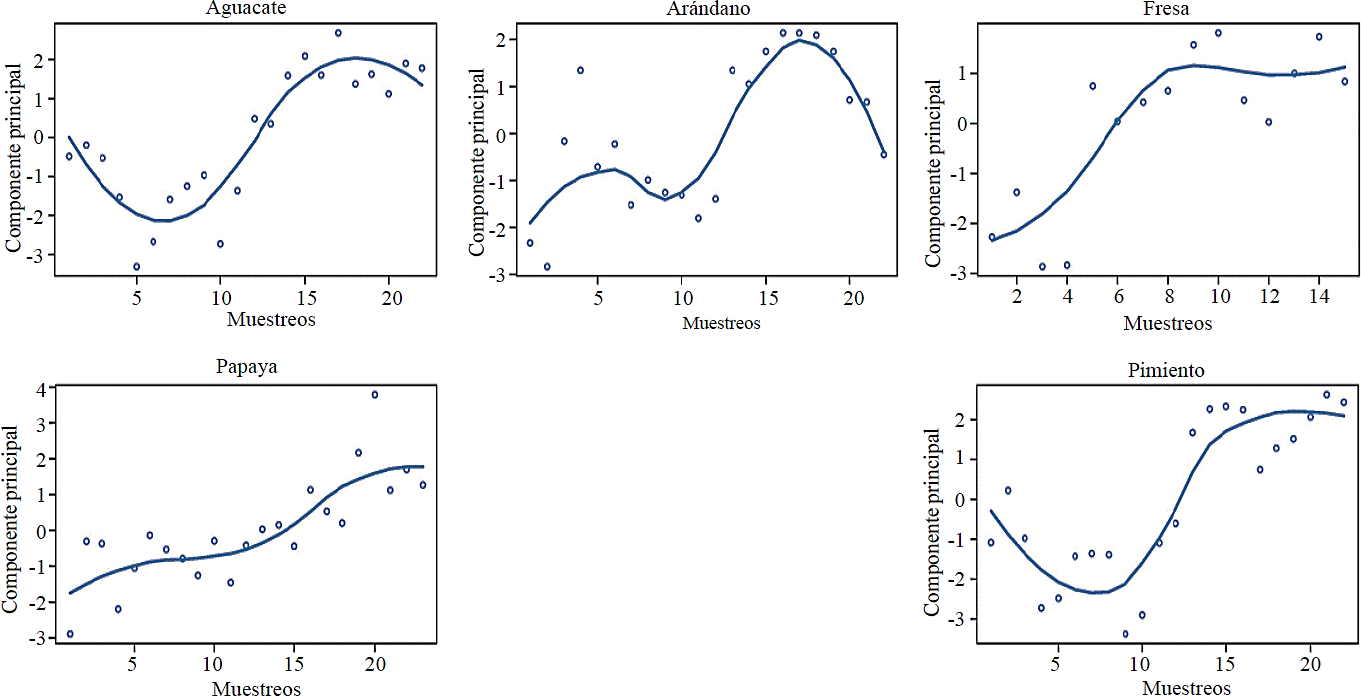Serviços Personalizados
Journal
Artigo
Indicadores
-
 Citado por SciELO
Citado por SciELO -
 Acessos
Acessos
Links relacionados
-
 Similares em
SciELO
Similares em
SciELO
Compartilhar
Revista mexicana de ciencias agrícolas
versão impressa ISSN 2007-0934
Rev. Mex. Cienc. Agríc vol.6 spe 12 Texcoco Nov./Dez. 2015
Articles
Dynamics of soil solution composition in crops from western Mexico
1Universidad Autónoma Agraria Antonio Narro- Departamento de Horticultura Calzada Antonio Narro 1923, C. P. 25315. Saltillo, Coahuila, México.
2Centro de Investigación y de Estudios Avanzados-Instituto Politécnico Nacional-Robótica y Manufactura Avanzada, Unidad Saltillo, Avenida Industria Metalúrgica 1062, C. P. 25900, Parque Industrial, Ramos Arizpe, Coahuila. (williamnarvaezo@hotmail.com; america.morales@cinvestav.edu.mx; abenmen@gmail.com).
3Universidad Autónoma Agraria Antonio Narro- Departamento de Fitomejoramiento Calzada Antonio Narro 1923, C. P. 25315. Saltillo, Coahuila, México.
The present study is a preliminary and descriptive approach to the phenomenon of the dynamic behavior of soil solution. The objective was to study the composition of the soil solution over time, to help the understanding of the availability of different ions, as well as their individual and collective behavior through correlation and principal component analysis (PCA). The work consisted in gathering information by repetitive sampling of the solution in different soil types under intensive production areas located in western Mexico (Jalisco and Colima) for five crops (avocado, cranberry, strawberry, papaya and pepper). The soil solution samples were collected every 15 days throughout the phenological cycle for the different crops; the samples were analyzed for nitrates (NO3-), potassium (K+), calcium (Ca2+), sodium (Na+) levels, pH and electrical conductivity (EC). The results of the correlations showed similar patterns with a decreasing behavior among different ions versus time. Loading vectors obtained by PCA showed similarity in their behavior in all crops except strawberry; however the dynamics from the principal component for all crops was similar showing concomitant variation over time with an ascending trend. This result indicates the feasibility to model in multivariate ways the dynamic behavior of the soil solution.
Keywords: principal component; nutrient dynamics; soil solution
El presente estudio es un acercamiento preliminar y descriptivo al fenómeno del comportamiento dinámico de la solución del suelo. El objetivo del trabajo fue el estudio de la composición de la solución del suelo a través del tiempo, para ayudar al entendimiento de la disponibilidad de los diferentes iones, así como su comportamiento individual y colectivo mediante análisis de correlación y de componentes principales (ACP). El trabajo consistió en realizar colectas de información mediante muestreos repetitivos de la solución en diferentes tipos de suelo en zonas de producción intensiva ubicadas en el occidente de México (Jalisco y Colima) para cinco cultivos (aguacate, arándano, fresa, papaya y pimiento). Las muestras de solución del suelo fueron recolectadas en intervalos de 15 días a través de todo el ciclo fenológico para los diferentes cultivos; a las muestras se les determino el contenido de nitratos (NO3-), potasio (K+), calcio (Ca2+), sodio (Na+), pH y conductividad eléctrica (CE). Los resultados de las correlaciones mostraron patrones similares con un comportamiento decreciente entre los diferentes iones versus el tiempo. Los vectores de carga obtenidos mediante el método del ACP mostraron similitud en su comportamiento en todos los cultivos a excepción del cultivo de fresa, no obstante la dinámica del componente principal para todos los cultivos fue similar mostrando variación concomitante a través del tiempo con una clara tendencia ascendente. Este resultado indica la factibilidad de modelar de forma multivariada el comportamiento dinámico de la solución del suelo.
Palabras clave: componente principal; dinámica nutrimental; solución del suelo
Introduction
Soil is a natural body and a complex open system from an energy and matter flow point of view. It is the result of several formation factors, such as the time, parent material, climate, vegetation, organisms and topography, integrated into a system with multiple interactions. For this reason, soil should not be conceptualized as a static system, but as a complex and dynamic system (Jenny, 1994) that in order to study it, we fragmented into its components, placing them in the physical, chemical and biological fields. The components develop interactions and local transformations and generate the edaphic system (Hernández-Jiménez et al., 2006) that we use for agricultural production and generally studied from a physical point of view (determining texture, structure, depth profile, water capacity retention, drainage, etc.), chemical (determining pH, EC, disposition level of essential elements, cation / anion exchange capacity, etc.) or biological (collecting and sorting a small part of living organisms that soil contains in different species and populations) characterizing in this was soil fertility (Benton-Jones, 2012).
Soils are made up of three phases: solid, liquid and gaseous (Sposito, 1981). The relationship and operation of the three phases depend on complex physical, chemical and biological interactions and transformations. The solid phase consists of different particles or aggregates (Brady and Weil, 1999) of inorganic of inorganic or organic nature with different granulometry. The inorganic part is related to the colloidal soil content coming from the parent material after being subjected to physical, chemical and biological weathering changing their physicochemical properties (Gines Navarro and Navarro, 2003). Organic particles or aggregates, collectively called organic matter, accumulate thanks to constant supply of material from organisms, either as waste or as a result of death.
This organic material is subjected to a series of complex transformations by soil microorganisms, resulting in the accumulation of colloids or organic molecules that contribute in a significant manner to the composition and soil fertility (Gines-Navarro and Navarro, 2003). Together the inorganic and organic components of the solid phase lead to soil composition and properties (Buscot, 2005). The solid phase of the soil has higher stability, lower capability to change and can serve, in general, for soil characterization with taxonomic purposes. In comparison, the liquid and even more gaseous phase, have large and strong fluctuations which make them unsuitable for soil taxonomy (Gines Navarro and Navarro, 2003).
However, from the nutritional and crop management point of view the liquid phase is critical, because it is in direct contact with plant roots and is where plants take their nutrients (Khasawneh, 1971; Menguel and Kirby, 2001). This phase is constituted by water found in soil pores and is known as soil solution, available water or soil water (Gines-Navarro and Navarro, 2003). This phase of the soil system is per se a complex and dynamic system that reflects the overall impact of all biotic and abiotic components; including plant nutrition process (Snakin, 2001). Complex systems theory indicates that certain properties or behaviors generally are not predictable from the properties of individual system components (Garcia, 2006). For this reason, ground water being a complex dynamic system is expected that specific details of its composition will not be predictable from the physical and chemical properties of the individual components of the solid phase (Ryan, 2007). For this reason it is proposed to study soil solution in its composition and temporal variability, considering it as the primary source of water and nutrients for plants and whose composition is associated to large features with inorganic, organic and biotic components of the soil, but not dependent on details of the composition of the individual components of the solid phase; but rather from the interactions within each physical, chemical and biological components and between these with the prevailing climate in a certain time range.
To study the soil solution two properties are considered: the volume of liquid water and the composition of soil solution. The volume directly influences on composition and concentration of the soil solution, as if this change will affect ions concentration (Menguel and Kirby, 2001). Determining water volume is made through physical methods such as wet gravimetric method or by bulk density (Da) and true density (Ds) of the soil solid phase (Narro-Farias, 2004). The composition of soil solution is still a more complex situation, due to their dynamic behavior and its multicomponent nature (Khasawneh, 1971), which makes it difficult or even impossible to predict its behavior from the original components which are water and soil solid phase.
This topic of the composition of soil solution has been studied in some detail for polluted soils and technosols, where predictions in solubility of Cu, Zn, Cd and Pb (McBride et al., 1997) have been reported, as well as levels of Cd and Zn in the soil solution through phytoextraction with Thlaspi caerulescens (Knight et al., 1997) and radish (Lorenz et al., 1997). But for agricultural soils there is no published information available on dynamic behavior.
The present study is a preliminary and descriptive approach to the phenomenon of dynamic behavior of soil solution. The aim was to perform an analysis of the composition of soil solution over time during different growth stages in five crops under intensive production in western Mexico, which allows us to describe the present relationship between the different ions as well as their individual and collective behavior through a principal component analysis (PCA).
Methodology
The descriptive study of soil solution was performed in the West area of Mexico in the states of Jalisco and Colima, starting in the summer-autumn 2013 and ending in the winter of 2014. Monitoring soil solution was conducted in crops established in different agricultural enterprises. Crops evaluated for this study: avocado (Persea americana Mill.) and cranberry (Vaccinium sp.) located in Ciudad Guzman Jalisco at 19° 40' 43.2" N latitude, 103° 32' 06.9" W longitude and 19° 40' 53.13' N latitude, 103° 32' 41.77' W longitude respectively, strawberry (Fragaria L.) located in Tapalpa Jalisco (19° 55' 03.3 "N latitude, 103° 42 '11" W longitude), papaya (Carica papaya L .) in the municipality of Tecoman Colima (18° 48' 17.58' N latitude, 103° 45' 9.13" W longitude) and pepper (Capsicum annuum) in Sayula Jalisco (19° 54' 05.4" N latitude, 103° 35' 09.7" W longitude). At the time of study avocado was 5 years old while cranberry was one year old. For the rest of the crops monitoring began from planting stage.
The study included an analysis of the composition of soil solution over time. To do so, soil lysimeters Irrometer were installed. Six sampling stations were established for each crop and in each sampling station a replication was performed. For this reason, two lysimeters were placed on each station at a depth of 20 cm, at a distance of 20 cm from the plant, the minimum distance between one station and another was 500 m. Samples collection was made every 15 days throughout the crop cycle (Table 1).
Once installed the lysimeters obtaining samples was made by performing a vacuum of -70 kPa. This activity was carried out under field capacity conditions once fertigation was done. To determine field capacity counted with a tensiometer Irrometer R. The samples collection was performed 24 hours after vacumm.
Soil solution samples were analyzed in situ by portable equipment. pH was determined with a potentiometer Hanna HI98130, electrical conductivity (EC) was assessed using an equipment Horiba Spectrum Cardy Twin; ions were analyzed with ion-selective Horiba; for nitrate (NO3-) the B743 model was used; calcium (Ca2 +) with the B751 model; potassium (K +) with B731 model and sodium (Na +) with model B722.
Statistical analysis
An exploratory analysis, scatter plots and Pearson correlation matrix was performed. An unsupervised statistical analysis of principal components (ACP) with standardized values was made. PCA has many advantages (Broschat, 1979), is a technique that reduces the dimensionality of a set of multivariate data, removes existing interrelationships between variables, organizes data in orthogonal vectors where each of the variables within the vector behaves in a similar manner based on their correlations, each of these vectors is called a principal component. The first components express most of variance of orthogonal data and are a useful tool to simplify the analysis and interpretation of large amount of variables considered in an exhaustive assessment. Calculations were performed with the language and environment for statistical computing R version 3.1.1 (James et al., 2014).
Results and discussion
Dynamics of chemical variables over time for different crops
By observing nutritional dynamics of the different variables of soil solution over time (Figures 1-5) it can be appreciated in the different sites similar patterns in behavior regarding time and values and concentrations of different variables. In all cases pH values fluctuated, but always keeping a positive trend as samplings advanced, the values ranged from 5 to 7.8. EC showed a negative trend versus time for avocado, cranberry and pepper with initial levels of 0.8, 1.74 and 1.41 respectively, decreasing towards final stages to values of 0.4 dSm-1for avocado and cranberry and 1 dSm-1 for pepper. For strawberry and papaya the trend in EC was positive initiating with of 0.6 and 0.87 to 1.4 and 1.8 respectively. The concentration of Na+ and K+ showed a decreasing trend for all crops, showing fluctuations in certain samplings; for avocado, cranberry and strawberry Na+ values remained on an average range of 154 to 15 mg L-1 and K+ levels for the three cases showed increases in their early sampling dates of up to 296 mg L-1 as for cranberry, K+ levels decreased from 231, 296 and 76 to 17, 84 and 28 mg L-1 respectively. For papaya and pepper Na+ range was higher, taking values of 487 and 475 to 43 and 136 mg L-1, respectively, while K+ showed a milder decrease, starting in concentrations of 190 to 29 mg L-1 for papaya and from 62 to 2 mg L-1 for pepper. Ca2+ and NO3- showed the same dynamic pattern, decreasing in all crops except where papaya levels reached 580 and 620 mg L-1 respectively. For the rest of the crops Ca2+ and NO3- concentration in soil solution decreased showing ranges from 381 to 34 mg L-1 and 418 to 112 mg L-1 (avocado), 250 to 18 mg L-1 and 430 to 65 mg L-1 (cranberry), 180 to 59 mg L-1 and 547 to 271 mg L-1 (strawberry) and from 430 to 27 mg L-1 and 360 to 45 mg L-1 (pepper).
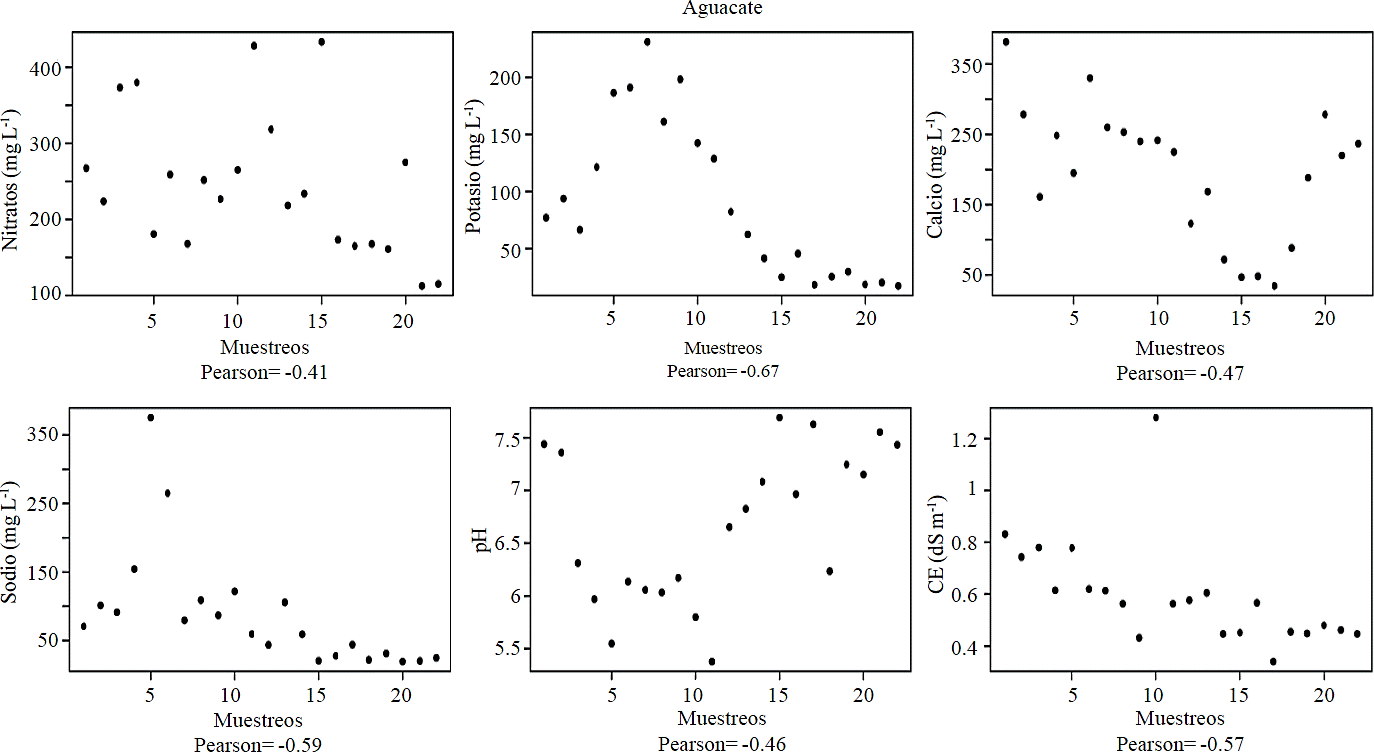
Figure 1 Dynamics of chemical variables over time for growing avocado, at the bottom of the graphs the Pearson correlation coefficient indicated.
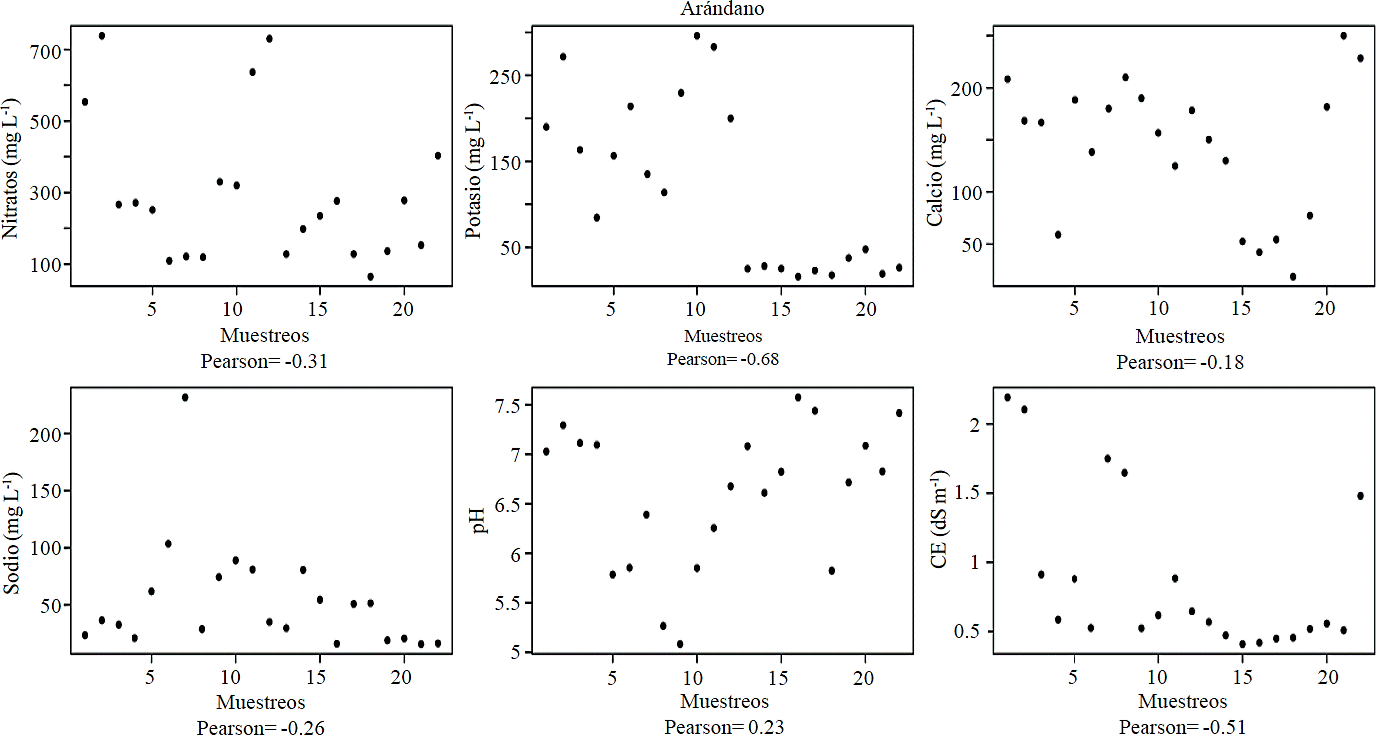
Figure 2 Dynamics of chemical variables over time for growing blueberry, at the bottom of the graphic Pearson correlation coefficient indicated.
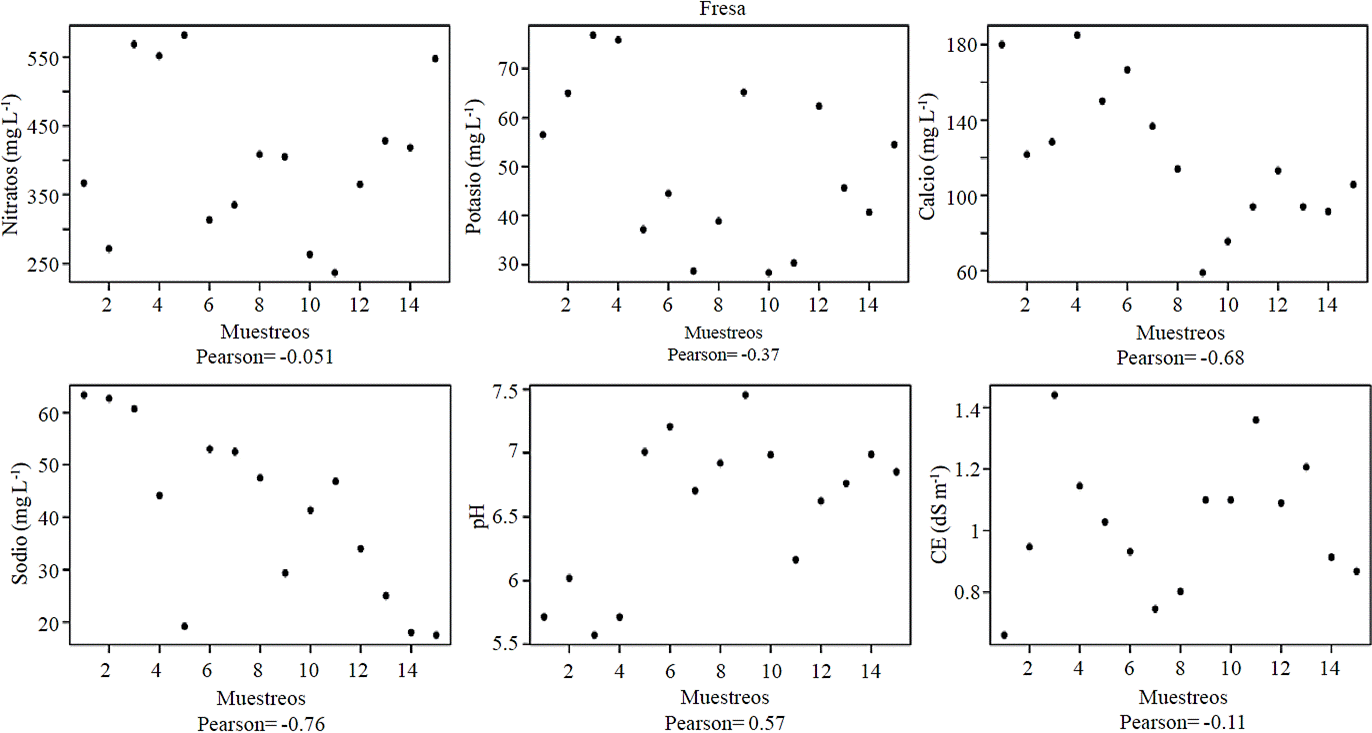
Figure 3 Dynamic chemical variables over time for the strawberry crop, at the bottom of the graphs the Pearson correlation coefficient indicated.
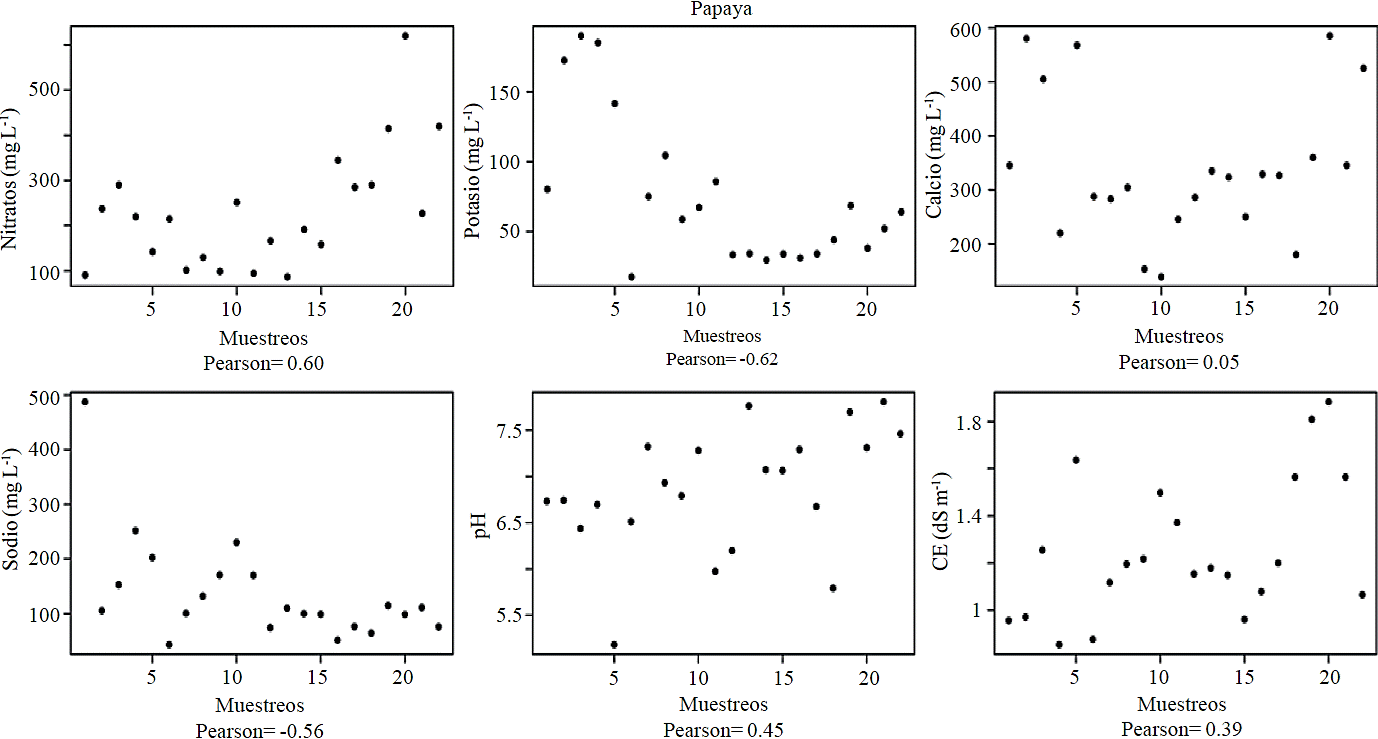
Figure 4 Dynamic chemical variables over time for growing papaya, at the bottom of the graphs the Pearson correlation coefficient indicated.
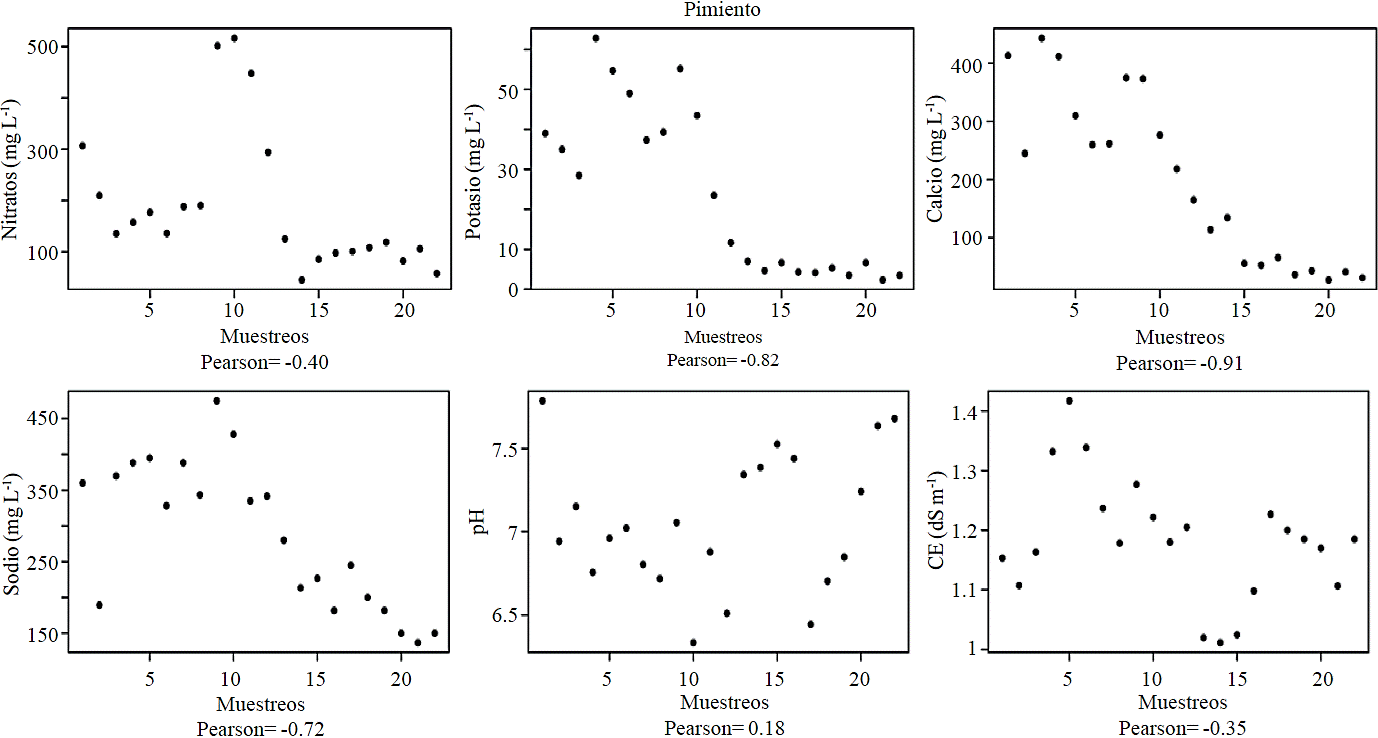
Figure 5 Dynamics of chemical variables over time for the pepper crop, at the bottom of the graphic Pearson correlation coefficient indicated.
The results found for NO3- in soil solution for most crops can be given by leaching processes and radical absorption (Navarro-Blaya and Navarro-García, 2003). Both processes may be associated not only with decreased NO3- but also with other ions (K+, Ca2+, Na+) and in general EC of soil solution.
For papaya (Figure 5) an opposite behavior in EC apparently associated to an increase in Ca2+ and NO3- present in soil solution was observed (Charley and McGarity, 1964; Menguel and Kirby, 2001).
For strawberry (Figure 3) the highest concentration of NO3- and K+ in soil solution is present in early stages, which was described by the absorption curves studied by Molina et al. (1993), who pointed out that in its early stages the absorption is very low, increasing simultaneous to fructification. The increasing dynamics from pH of soil solution, observed in all cultures studied, could be due to the alkalizing effect of nitrates from fertilizers applied (Snakin, 2001). Decreases in Ca2+ and K+ ions in soil solution is probably due to increased absorption as the crop passes from the vegetative stage to flowering and fruit set, this due to a preference in the absorption of these ions by avocado plants (Figure 1) (Maldonado-Torres et al., 2007), cranberry (Figure 2) (Ferreyra et al., 2001) and papaya (Figure 4) (Fallas, 2014).
This decreasing effect on ions present in the soil solution could be related to an increase in the absorption rate of nutrients as the crop grows as observed in strawberry case (Figure 3) (Avitia-Garcia et al., 2014) and pepper (Figure 5) (Rincón et al., 1995).
For cranberry another factor possibly involved in the reduction of ions in the soil solution (Figure 2), would on one hand the fixation in soil particles or in the case of sandy soils through leaching (Hancock and Draper, 1989). For decreasing Na+ in the soil solution (Figure 2) it has been reported that cranberry tends to absorb it in high levels in leaf tissue, this because it lacks a mechanism of regulating the uptake of this element (Spiers, 1983).
First principal component analysis
Data obtained in the study from the dynamics of the composition of soil solution for five different crops, underwent an unsupervised multivariate statistical analysis called principal component. Consisted in the creation of new variables called principal components from the original variables (NO3-, K+, Ca2+, Na +, pH and EC). With this method accomplished to create a linear function with which was possible to explain the multivariate behavior of the system comprised by the soil solution. For this purpose the values of the principal components were obtained and defined using only the first principal component which groups the highest variance. For avocado groups 50%, cranberry 40%, strawberry 40%, papaya 33% and pepper 62%.
The load vectors obtained for the first principal component (Table 2) were identified the highest absolute value for each crop studied, determining with this which variable contributed the most to the variation of the first component. For avocado and cranberry was the most important variable was K+, for strawberry pH, for papaya NO3- and pepper Na+. These characters of the soil solution could rule as conditioning variables (independent variables) (Jenny, 1994), in the dynamic behavior of the system and presumably are different in each culture for being different soils and geographical sites.
Table 2 Vectors standardized load the first principal component of the different variables evaluated for different crops.

Despite soil and crops diversity, it was found in the behavioral set of load vectors a pattern in all crops: the values of load coefficients were positive for pH and negative for most of the remaining cases (Table 2). This result indicates that in all cases pH tends to rise during crop growth, indicating a deficit in the protonation of soil solution, possibly resulting from the absence of a suitable concentration of organic matter, which is known to be the repository for exchanging e-/H+ (Menguel and Kirby, 2001) and the aforementioned effect of alkalinization by applying NO3- in fertilizers (Snakin, 2001). The rest of the coefficients, of negative sign, indicate the trend towards decline in the availability of mineral nutrients in soil solution. A possible explanation for this would be insufficient capacity of the solid phase of the soil to provide the necessary nutrients in the soil solution (Menguel and Kirby, 2001) to cover all crops needs, this despite the contribution of fertilizers via fertigation.
By observing the dynamic behavior of the first principal component it can be seen the variability of the observations versus time or samples number, finding that the dynamics of the first principal component was similar to the six crops, with a clear upward trend (Figure 6). This rising trend is largely governed by the variables with greater weight in the first principal component.
These variables, through load coefficients, are negative for avocado, cranberry and pepper, while for strawberry and papaya are positive. A possible answer to this similarity would be given by pH of the soil solution over time, which as mentioned previously, for all cases showed positive correlation (Figure 1, 2, 3 and 5) and is associated in a very similar way to the principal component (Figure 6) over time. This happens for all crops except papaya (Figure 4), where NO3- plays a key role in the rising behavior of the principal component. In all cases the first component shows a positive trend over time, which indicates the possible presence of a temporal pattern in joint dynamics of the attributes of the soil solution.
These results seem to suggest on one hand the effectiveness of the first principal component in shaping joint dynamics of soil solutions in different crops; in particular, it is an integration of the results presented above in univariate analysis of different ions for different crops over time.
On the other hand, the dynamics described indicates the plausibility of modeling the behavior of a complex system such as soil solution, while not using any single variable or group of variables analyzed individually, but a linear function of the variables determined in soil water. It is possible that increasing the number of variables determined in the soil solution the modeling power is higher to predict the joint dynamic behavior. Such studies should be performed to verify if the study of the soil solution can be a useful supplement to traditional studies in the solid phase of the soil.
From Dokuchaev times raised that the knowledge of soils is the mean to dominate and lead them with goals applied to agriculture (Hernandez-Jimenez et al., 2006). Based on the findings of this research can be inferred that it is possible to predict nutrient dynamics of soil solution in soils with agricultural management. This behavior could be modified by changing crop management and/or land use and therefore have consequences on the pattern of the principal component. This effect in modifying the soil solution has been reported by Snakin et al. (2001), who indicates that in forest soils without human intervention the variability of the solution tends to decrease, which could make the predictive study of the soil solution easier.
The author indicates that human activities could create dynamic heterogeneity additional to that arising naturally in certain soil characteristics. The latter supports the findings in this study where agricultural soils on the one hand seem to show a similar multivariate dynamic that seems to suggest common patterns of behavior in different systems, but with specific heterogeneities in the case of each crop and surely comes from each specific combination soil - plant species- agronomic management. Also have been reported results of a daily cyclical behavior of pH, redox potential and calcium in the soil solution in forests (Snakin, 1983), but without finding similar trends in the different soils. Currently there is no information on the composition dynamics of the soil solution over time for crops as well as for multivariate statistical analyzes that attempt to explain or predict the behavior of the soil solution system.
It is essential to continue with these types of studies and repeat them in subsequent years adding more variables as well as other ions (NH4+ Mg2+, H2PO4-, SO42-, CO32- Mn2 +, Fe2 +, Cu2 +, H3BO3, Zn2 +, MoO42-, Si(OH)4, Al3 +, etc.), oxide reduction potential (ORP), concentration of organic acids (malate, citrate, lactate, etc.), titratable acidity, populations and species of bacteria, fungi and protists or metagenomic studies thereof, among others. It would also be of great importance to perform such work under natural conditions without human intervention or in rainfed, reduced tillage or organic farming areas, to determine if in spite of the different soil conditions exist common patterns among them as those are described in this study.
This study explores the broad picture about soil composition and its behavior. It offers the prospect of evaluating the soil solution as a complement to classical physicochemical determinations performed on samples of the soil solid phase.
From the methodological point of view, this paper illustrates the usefulness of principal component analysis, as a useful tool for the descriptive study of the soil solution, as being a complex and dynamic system it consists of many elements that govern their behavior both individually and collectively. Studying the individual components separately without an integrative dimension reduction tool, would fail in exploring joint dynamics from soil solution systems, where not only considers the behavior of individual attributes, but the system as a whole that emerges from the components connected by its interactions and interdependencies.
Conclusions
The individual behavior of chemical variables of the soil solution showed similar response patterns for avocado, cranberry and pepper with negative trends for all variables except pH. This same behavior was exhibited by strawberry with the difference that in addition to pH, EC also tended to increase over time.
For papaya chemical variables such as NO3-, Ca2+, pH and EC showed an upward trend against time while the K+ and Na+ were reduced.
The study demonstrated the feasibility of applying multivariate simulation in describing the dynamic behavior of the soil solution.
The results show that regardless of soil type, location and even crop, there are similar behavior patterns and potentially predictable that would allow predicting the dynamic behavior of the soil solution.
Literatura citada
Avitia-García, E.; Pineda-Pineda, J.; Castillo-González, A. M.; TrejoTéllez, L. I.; Corona-Torres, T. y Cervantes-Urbán, E. 2014. Extracción nutrimental en fresa (Fragaria x ananassa Duch.). México. Revista Mexicana de Ciencias Agrícolas. 3(5):519-524. [ Links ]
Benton-Jones, J. J. 2012. Plant nutrition and soil fertility manual (second edition). CRC Press Taylor & Francis Group. Boca Raton, Florida, USA. 271 p. [ Links ]
Brady, N. C. and Weil, R. R. 1999. The nature and properties of soils. 12th Ed. Prentice Hall. Upper Saddle River, New Jersey. USA. 881 p. [ Links ]
Broschat, T. K. 1979. Principal component analysis in horticultural research. United States. HortScience 14(1):114-117. [ Links ]
Buscot, F. 2005. Microorganisms in Soils: Roles in Genesis and Functions. Springer. Berlin, Alemania. 403 p. [ Links ]
Charley, J. L. and McGarity, J. L. 1964. High soil nitrate-levels in patterned saltbush communities. United Kingdom. Nature. 201:1351-1352. [ Links ]
Fallas, R.; Bertsch, F. y Barrientos, M. 2014. Curvas de absorción de nutrientes en papaya (Carica papaya L.) CV. “Pococí” en las fases de crecimiento vegetativo, floración e inicio de cosecha. Costa Rica. Agronomía Costarricense. 38(2):43-54. [ Links ]
Ferreyra, E. R.; Peralta, C. J.; Sadzawka, R. A.; Muñoz, S. C. and Valenzuela, V. J. 2001. Efecto de la acidificación del sustrato y del agua de riego en la nutrición, desarrollo y producción de arándano ojo de conejo (Vaccinium ashei Reade). Chile. Agricultura técnica. 61(4):452-458. [ Links ]
García, R. 2006. Sistemas complejos: conceptos, métodos y fundamentación epistemológica de la investigación interdisciplinaria. Gedisa Editorial. Barcelona, España. 199 p. [ Links ]
Gareth, J.; Witten, D.; Hastie, T. and Tibshirani, R. 2014. An Introduction to Statistical Learning with Applications in R. Springer. New York. USA. 419 p. [ Links ]
Hancock, J. F. and Draper, A. D. 1989. Blueberry culture in North America. USA. Hortscience. 24(4):551-556. [ Links ]
Hans, J. 1994. FACTORS OF SOIL FORMATION A System of Quantitative Pedology. Dover Publications, INC. New York, New York, USA. 271 p. [ Links ]
Hernández-Jiménez, A.; Ascanio-García, M. O.; Morales-Díaz, M.; Bojórquez-Serrano, J. I.; Garcia-Calderon, N. E. y GarcíaParedes, J. 2006. EL SUELO: fundamentos sobre su formación, los cambios globales y su manejo. Universidad Autónoma de Nayarit. Nayarit, México. 231 p. [ Links ]
Khasawneh, F. E. 1971. Solution Ion Activity and Plant Growth. USA. Soil Sci. Soc. Amer. 35:426-436. [ Links ]
Knight, B.; Zhao, F. J.; McGrath, S. P. and Shen, Z. G. 1997. Zinc and cadmium uptake by the hyperaccumulator Thlaspi caerulescens in contaminated soils and its effects on the concentration and chemical speciation of metals in soil solution. Netherlands. Plant and Soil. 1(197):71-78. [ Links ]
Lorenz, S. E.; Hamon, R. E.; Holm, P. E.; Domingues, H. C.; Sequeira, E. M.; Christensen, T. H. and McGrath, S. P. 1997. Cadmium and zinc in plants and soil solutions from contaminated soils. Netherlands. Plant and Soil. 1(189):21-31. [ Links ]
Maldonado-Torres, R.; Álvarez-Sánchez, M. E.; Almaguer-Vargas, G.; Barrientos-Priego, A. F. y García-Mateos, R. 2007. Estándares nutrimentales para aguacatero “hass”. México. Revista Chapingo Serie Horticultura. 13(1):103-108. [ Links ]
Mcbride, M.; Sauve, S. and Hendershot, W. 1997. Solubility control of Cu, Zn, Cd and Pb in contaminated soils. United Kingdom .European Journal of Soil Science. 2(48):337-346. [ Links ]
Mengel, K. and Kirkby, E. A. 2001. Principles of Plant Nutrition (5th Edition). Springer. Dordrecht, The Netherlands. 807 p. [ Links ]
Molina, E.; Salas, R. y Castro, A. 1993. Curva de crecimiento y absorción de nutrimentos en fresa (Fragaria x ananassa Duch. Cv. Chandler) en Alajuela. Costa Rica. Agronomía Costarricense. 17(1):63-67. [ Links ]
Narro-Farías, E. 2004. Física de suelos: con enfoque agrícola. Editorial Trillas. México D. F, México. 195 p. [ Links ]
Navarro-Blaya, S. y Navarro-García, G. 2003. Química Agrícola. Mundiprensa. Barcelona, España. 479 p. [ Links ]
Snakin, V. V. 1983. Some soil regimes by in situ-metry data. In: Russian chernozem. A hundred years after Dokuchaev. Kovda, V. A and Samoilova, E.M. (Eds.). Nauka PubL. Moscow, Russian. 79-89 pp. [ Links ]
Snakin, V. V.; Prisyazhnaya, A. A. and Kovács-Láng, E. 2001. Soil Liquid Phase Composition. ElSevier Science B. V. Amsterdam, The Netherlands. 316 p. [ Links ]
Spiers, J. M. 1983. Influence of N, K, and Na concentration on growth and leaf element content of "tifblue" rabbiteye blueberry. USA. HortScience. 18(1):223-224. [ Links ]
Sposito, G. 1981. The thermodynamics of soil solutions. Oxford Clarendon Press. New York, United States. 223 p. [ Links ]
Rincón, L.; Saez, J.; Balsalobre, E. y Pellicer, C. 1995. Crecimiento y absorción de nutrientes del pimiento grueso en cultivo bajo invernadero. España. Invest. Agr. Prod. Prot. Veg. 10(1):47-59. [ Links ]
Ryan, A. J. 2007.Emergence is coupled to scope, not level. United States. Complexity. 13(2):67-77. [ Links ]
Received: September 2015; Accepted: December 2015











 texto em
texto em 


